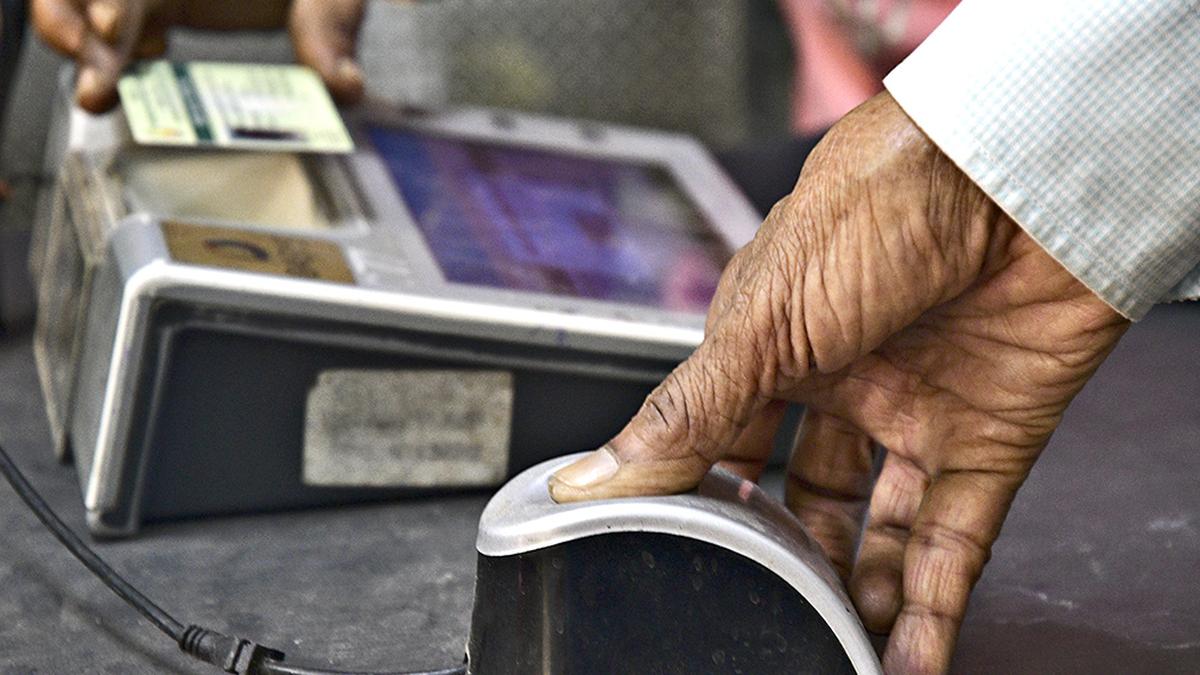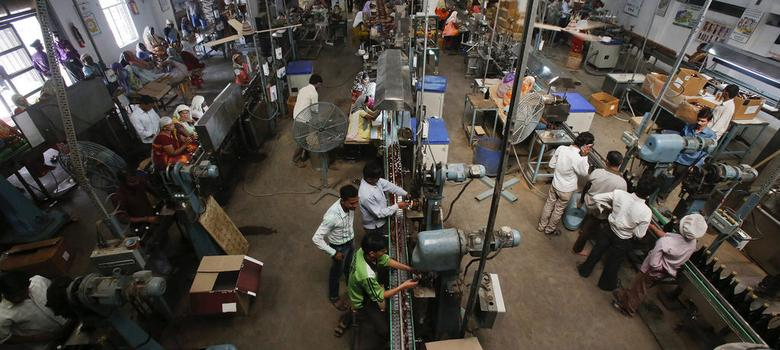
Copyright infringement not intended
Picture Courtesy: scroll.in
Context: The 'State of Working India 2023' report, released by Azim Premji University’s Centre for Sustainable Employment, presents several key findings regarding India's labour market.
Key Highlights
Economic Mobility for Sons of Casual Wage Workers
- Between 2004 and 2018, there was an upward trend in economic mobility for sons of fathers engaged in casual wage employment. This means that these sons were less likely to follow in their fathers' footsteps and more likely to pursue informal, semi-formal, or formal regular-wage work.
- However, this upward trend was weaker for Scheduled Caste (SC) workers compared to general caste workers. SC workers faced more challenges in breaking away from casual wage work and transitioning to more stable employment.
Impact of Employed v/s Unemployed Mother-in-Law on Married Women's Employment
- The presence of an employed mother-in-law has a positive impact on the likelihood of married women being employed, especially in urban areas. Employed mothers-in-law may provide support or encouragement for women to participate in the workforce.
- The presence of an unemployed mother-in-law significantly reduces the likelihood of married women being employed, both in rural and urban areas. Unemployed mothers-in-law may contribute to household responsibilities, limiting the need for additional family income through women's employment.
Changing Composition of Employment Type by Caste
- Between 1983 and 2021, the proportion of regular wage workers from the Scheduled Caste (SC) category increased, although it remained lower than that of general caste workers. This suggests some progress in formal employment for SC workers.
- General caste workers had a higher rate of self-employment and were over-represented in larger enterprises. This indicates that general caste individuals had more entrepreneurial opportunities and access to larger business ventures.
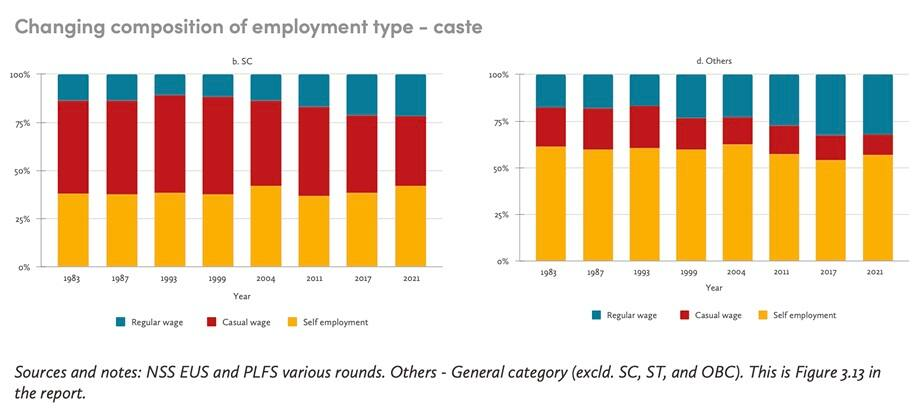
Intergenerational Mobility Matrices by Caste
- In 2018, economic intergenerational mobility was more pronounced for general caste casual wage workers compared to SC/ST workers. This means that sons of general caste casual wage workers were more successful in moving away from casual wage work.
- Sons of casual wage workers shifted away from casual wage work to informal, semi-formal, and formal regular wage work, indicating an aspiration for more stable and secure employment.
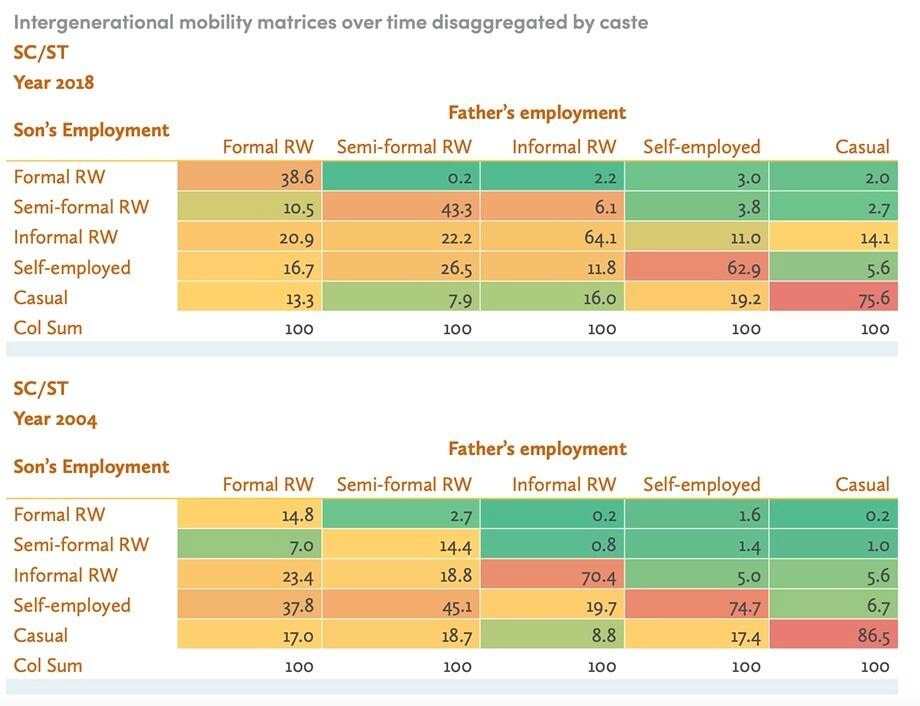
Representation of Women and SCs in Industries
- Between 1983 and 2021, there was an increase in women's representation in industries such as tobacco, education, health and social work, and textiles. However, women remained over-represented in these sectors compared to men.
- The degree of SC representation declined in some industries despite continuing to be over-represented compared to other castes. This suggests disparities in the distribution of employment opportunities.
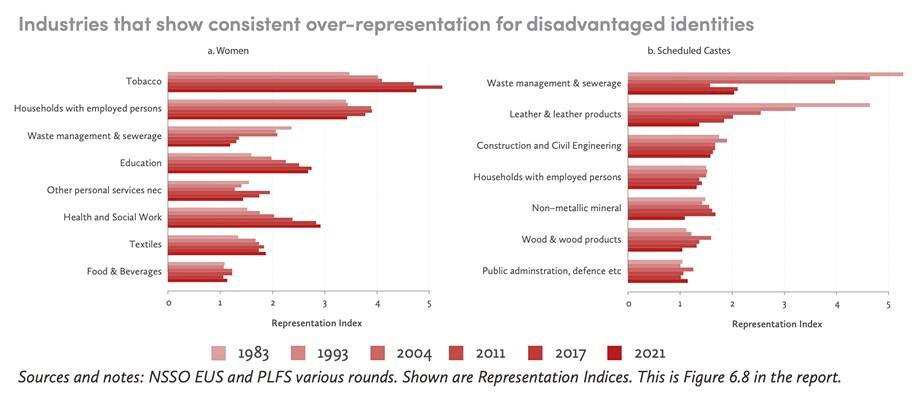
Relationship Between Husband's Earnings and Women's Employment
- The "male breadwinner" norm influenced women's employment. As a husband's income increased, the probability of the wife being employed decreased. This norm implies that when the husband earns more, there is less perceived need for the wife to work outside the home.
- In urban areas, there was a U-shaped pattern, indicating that as the husband's earnings exceeded a certain threshold, the probability of the wife being employed increased. This may be due to better-educated wives in higher-income households having access to well-paid work.
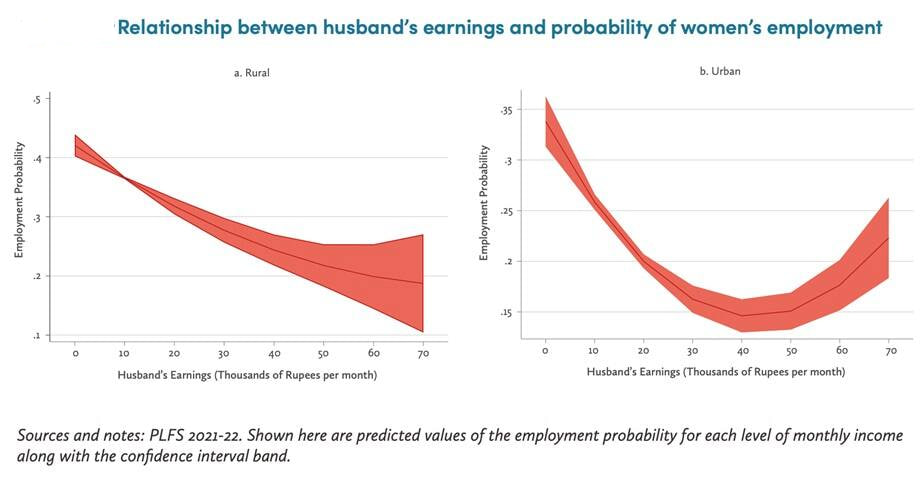
Female Workforce Participation Rates by Education
- Women in rural areas generally had higher workforce participation rates across all education levels compared to urban women. This could be attributed to factors like agricultural work opportunities in rural areas.
- Urban women exhibited a U-shaped trend in workforce participation as education levels increased. This suggests that urban women with higher education levels were more likely to find well-paying jobs, but there was a disconnect between job demand and supply.
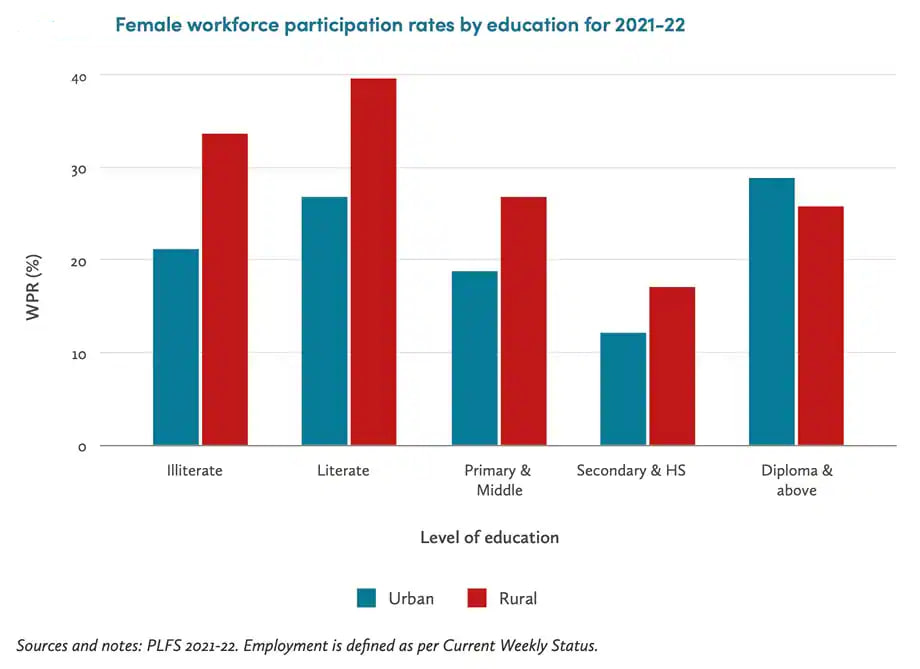
Rising Share of Non-Agricultural Workers
- Since the 1980s, there has been a significant increase in the share of workers employed in non-agricultural sectors, reaching 19.8% in 2021. This shift indicates a transition away from agriculture.
- Workers leaving the agricultural sector often took up casual wage labour or informal regular wage work in construction or services, indicating that alternative employment opportunities were not in organized or salaried sectors.
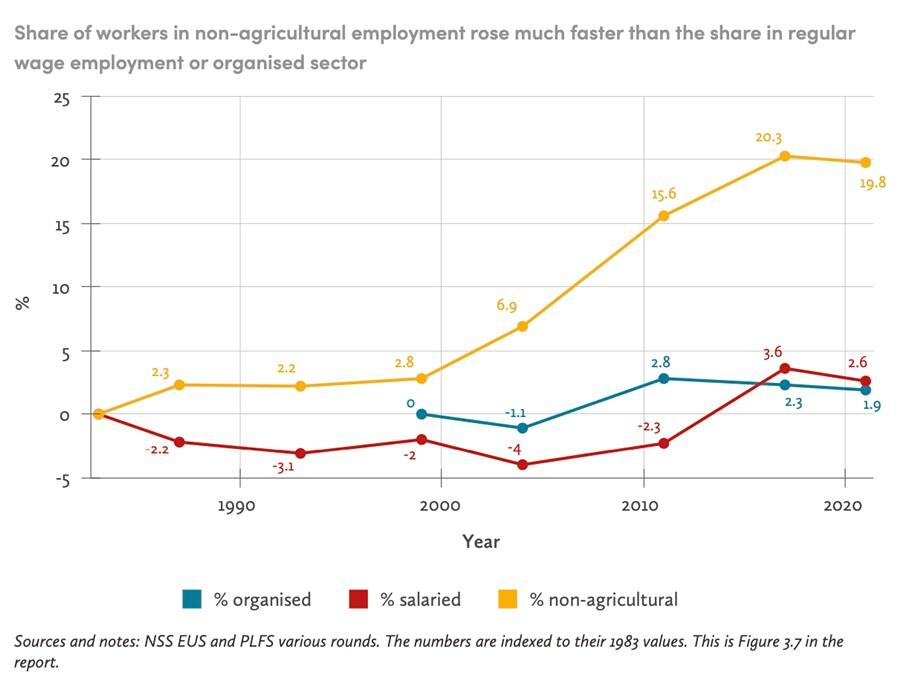
Unemployment Among Educated Youth
- Graduates under 25 years had the highest unemployment rate among all education levels for the same age group. This highlights the challenge of youth unemployment in India.
- Unemployment rates decreased as individuals grew older, primarily because long-term unemployment became unsustainable, and individuals likely gained work experience or found job opportunities over time.
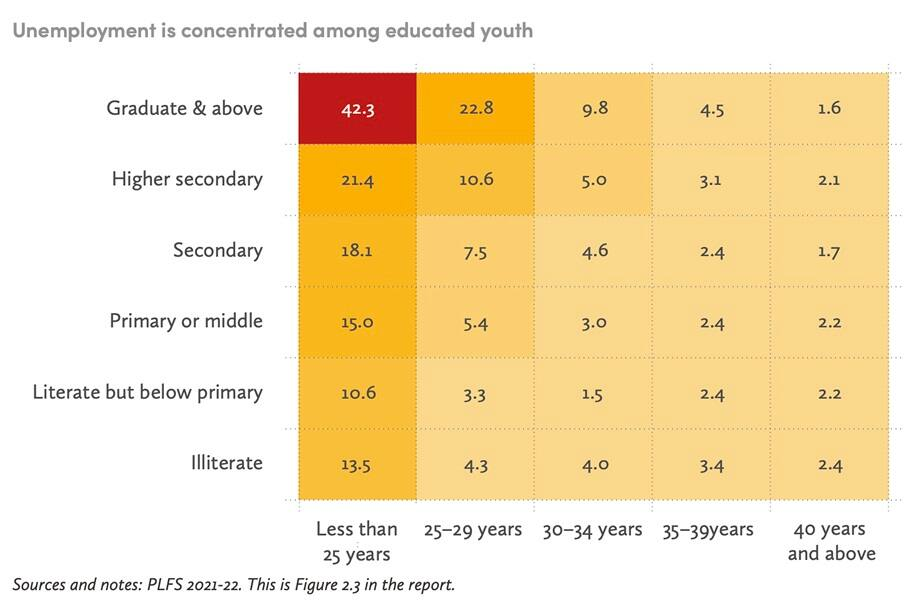
Significance of the report
- Data-Driven Insights: The report provides valuable data-driven insights into India's labour market. In a country as vast and diverse as India, having reliable data on employment trends and patterns is crucial for informed decision-making. This data helps policymakers, researchers, and the public understand the complexities and nuances of the labour market.
- Highlighting Disparities: The report sheds light on disparities in employment opportunities based on factors such as caste, gender, and education. These disparities are often a reflection of social and economic inequalities. By drawing attention to these disparities, the report underscores the need for targeted interventions and policies to address these inequalities and promote inclusivity in the labour force.
- Informed Decision-Making: With access to data-backed insights, the government and other stakeholders can make more informed decisions. This includes the formulation of policies and programs aimed at improving labour market conditions. Informed decision-making is critical for addressing the challenges and harnessing the opportunities within India's diverse and evolving workforce.
Steps taken to enhance employment opportunities and address labour market challenges
- Make in India Initiative: The "Make in India" initiative aims to promote manufacturing and attract foreign investment. By encouraging the growth of manufacturing industries, this initiative seeks to create job opportunities and boost economic growth.
- National Rural Employment Guarantee Act (NREGA): NREGA, introduced in 2005, guarantees 100 days of wage employment to rural households, thereby providing a safety net for rural workers during lean agricultural seasons. It has been instrumental in reducing rural unemployment and improving the livelihoods of marginalized communities.
- Skill India Mission: The Skill India Mission was launched to enhance the employability of the Indian workforce by providing skill development and vocational training. It focuses on equipping individuals with the skills required for various industries, thus addressing the skills gap and increasing their chances of gainful employment.
- Beti Bachao, Beti Padhao: This initiative, launched in 2015, seeks to promote the education of girls and empower them. By encouraging female education, it aims to increase the participation of women in the workforce, which is crucial for inclusive economic growth.
- Startup India: This program, launched in 2016, aims to foster entrepreneurship and promote the growth of startups in India. Supporting innovative business ventures, not only creates job opportunities but also contributes to economic dynamism.
- Digital India: The Digital India initiative aims to digitize various sectors of the economy, including education and employment services. This digital transformation can enhance access to information, job portals, and online training, making it easier for job seekers to find opportunities and develop their skills.
- Pradhan Mantri Mudra Yojana: This scheme, launched in 2015, provides loans to micro and small businesses, helping them grow and generate employment. It supports entrepreneurship at the grassroots level.
- National Skill Development Corporation (NSDC): The NSDC plays a pivotal role in implementing skill development initiatives across various sectors. It partners with training providers and industry stakeholders to ensure that skill development programs align with industry needs.
Challenges in the labour market and employment landscape
- Unemployment: High levels of unemployment, particularly among educated youth, are a pressing issue. Despite having the necessary qualifications, many young people struggle to find suitable employment opportunities. Addressing this challenge requires concerted efforts to create jobs and provide skill development programs that align with market demand.
- Gender Disparities: Gender-based disparities in the workforce persist. Women often face barriers to employment, including societal norms that limit their participation in certain industries or roles. Additionally, concerns about safety in the workplace and during commutes can discourage women from seeking employment opportunities. Closing the gender gap in the labour force is crucial for economic growth and gender equality.
- Caste-based Inequalities: The report highlights disparities in employment opportunities based on caste, indicating the presence of caste-based inequalities. In many cases, lower-caste individuals may face discrimination and limited access to quality education and job opportunities. Inclusive policies are needed to address these disparities and promote social equity.
- Informal Employment: A significant portion of the workforce is engaged in informal employment, characterized by a lack of job security, social benefits, and legal protections. This informal sector workforce is vulnerable to economic shocks and often faces exploitation. Transitioning informal workers to formal employment arrangements is a complex challenge that requires comprehensive labour reforms.
- Agricultural Transition: The shift away from agriculture to other sectors raises concerns about the absorption of agricultural labour. As mechanization and modernization occur in agriculture, many rural workers may need to find alternative sources of livelihood. This transition should be managed effectively to prevent widespread unemployment and ensure that displaced agricultural labourers have access to alternative employment opportunities.
Way forward for addressing India's labour market challenges and promoting inclusive economic growth
- Job Creation Diversification: India should diversify its economy by investing in sectors beyond agriculture. Encouraging the growth of manufacturing, technology, and services industries can create a more diverse range of employment opportunities, reducing the dependence on agriculture.
- Skills Development and Vocational Training: Continuing to emphasize skill development and vocational training programs is essential. These programs should be designed to align with industry needs and provide individuals with the skills required for gainful employment.
- Gender Inclusivity: Promoting gender inclusivity in the workforce is critical. This can be achieved through policies that support women's workforce participation, such as maternity leave provisions, safe workplace environments, and initiatives that challenge societal norms and stereotypes.
- Social Safety Nets: Strengthening social safety nets and social security measures is vital, especially for workers in the informal sector who lack job security and benefits. Expanding access to affordable healthcare, unemployment benefits, and retirement savings programs can provide a safety net for vulnerable workers.
- Education Access: Ensuring quality education and vocational training are accessible to all segments of the population is essential. This requires addressing educational disparities, improving the quality of schools and vocational training centres, and promoting lifelong learning opportunities.
- Data Collection and Analysis: Regular data collection and analysis of labour market trends, as exemplified by reports like the "State of Working in India," should be encouraged. This data-driven approach can help policymakers make informed decisions and adapt strategies to changing labour market dynamics.
- Entrepreneurship and Small Businesses: Encouraging entrepreneurship and supporting the growth of small and medium-sized enterprises (SMEs) can lead to job creation. Simplified regulations, access to credit, and business development support can foster entrepreneurial endeavours.
- Labour Reforms: Labor laws and regulations should be reviewed and reformed to strike a balance between worker protection and business flexibility. Reforms can help formalize informal labour, making it easier for workers to access social security benefits.
- Rural Development: Addressing the challenges of agricultural transition requires comprehensive rural development strategies. These should include investments in rural infrastructure, access to markets, and diversification of rural livelihoods.
- Public-Private Collaboration: Collaborative efforts between the government, private sector, and civil society organizations are essential for the successful implementation of these initiatives. Public-private partnerships can drive job creation and skill development.

Conclusion
- The 'State of Working India 2023' report provides crucial insights into India's labour market. It highlights the pressing issue of youth unemployment, emphasizes the need for inclusive policies to address caste and gender disparities, and underscores the influence of family dynamics on women's workforce participation. To foster economic growth, India must prioritize job creation, skill development, and gender inclusivity while bridging rural-urban gaps and promoting education access. This report serves as a valuable resource for informed policymaking and intervention strategies in India's evolving workforce landscape.
Must Read Articles:
INDIA’S AGEING WORKFORCE: https://www.iasgyan.in/daily-current-affairs/indias-ageing-workforce
UNEMPLOYMENT IN INDIA: https://www.iasgyan.in/daily-current-affairs/unemployment-in-india-9
|
PRACTICE QUESTION
Q. What is the current employment status in India, and what are the main challenges faced by the country in terms of unemployment and underemployment? What strategies and initiatives are being pursued to address these challenges and pave the way for improved employment opportunities and inclusive economic growth?
|
https://indianexpress.com/article/explained/explained-economics/state-of-working-india-report-jobs-unemployment-women-explained-8949585/













